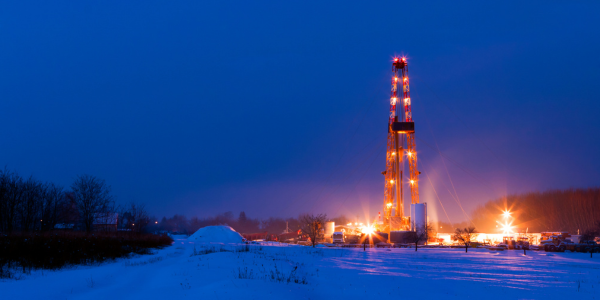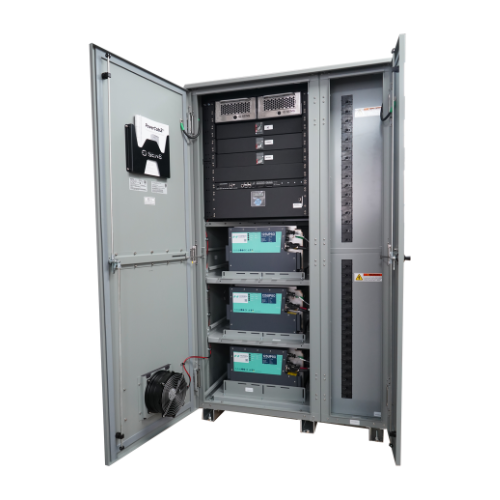
Outposts on Planet Earth: How to Power Remote Oil & Gas Operations
Drive two hours beyond the last service station and you reach a pipeline pump site that looks rather sleepy. Then you notice the constant hum of pump motors and the staccato chatter of telemetry radios. No crew is stationed here, yet valves must cycle on schedule, shutdown solenoids must trip instantly if pressure spikes, and radios must keep reporting in all weather conditions.
In oil and gas (drilling sites, pipeline compressor/pump stations, storage terminals, refineries), these unattended sites are the rule rather than the exception, and every one of them depends on a small, unseen DC power system. If that system falters the cost can shoot up quickly - from lost throughput to safety incidents that trigger regulatory scrutiny.
This article reviews the core power challenges that upstream, midstream, and downstream facilities share, describes what an ideal remote‐power design looks like, and then explains how integrated DC solutions can align with those requirements and can save you significant cost.
Challenges all around
A pump or compressor station miles from the nearest substation often leans on a diesel genset or a small solar array, which means the onsite DC system has to absorb every generator hiccup and cloud-shadow voltage sag. What would be a momentary nuisance in Houston can turn into hours of downtime on a prairie line where the closest technician is still bouncing along gravel roads. So to get reliable power is the first hurdle.
This is only amplified by the environment. Depending on location, conditions span −20 °F winters on the northern plains to 110 °F summer heat in West Texas, while coastal and offshore sites add salt spray, high humidity, and many sites are subject to constant vibration. Passive or active cooling must keep the system within operating temperatures, without drawing contamination onto sensitive electronics.
But rugged hardware alone is not enough - safety standards tighten the screws further. Safety standards narrow the design window. In hydrocarbon areas, battery systems must not create an ignition source. Specify solutions with minimal routine emissions, offering protections against uncontrolled venting under abnormal conditions. Back this with the right labels: UL listing, IBC seismic. Compliance is the ticket that lets equipment onto the pad.
Even when a system clears those hurdles, it still has to fit. Offshore platforms and skid houses measure usable space in inches, and every pound competes with revenue-producing equipment. Wall or pole mounts often replace floor racks, while in larger sites, floor-mounted systems need to go vertical as efficiently as possible to minimize footprint. Lightweight power conversion technologies and battery chemistries can tip the scale in favor of approval.
Once installed, the system has to look after itself. A single service call to a remote valve station can eat a day’s budget, so operators favor long-life, maintenance-free batteries and remote telemetry that warns of potential impending battery failure or inability to sustain the load. The goal is to visit by exception, not by schedule.
Because staffing is thin and distances are long, teams increasingly insist on factory-integrated solutions. A cabinet that ships pre-wired and factory-tested eliminates on-site wiring errors, compresses commissioning time, and frees engineers to focus on process equipment instead of assembling chargers, breakers, and batteries one component at a time.
The Ideal Remote DC System
This practical checklist stems from our experience with hundreds of field installations:
- Rugged enclosure - NEMA 3R/3RX minimum, sealed electronics to avoid contamination brought in by cooling fans.
- Redundant power conversion - modular rectifiers that share load and keep working if one fails.
- Battery chemistry matched to environment - design life of at least ten years at 95 °F, minimal maintenance.
- Compact technologies packaged efficiently to minimize space requirements.
- Flexible mounting - for units destined for smaller remote locations, a choice of floor, wall, or pole brackets so the same platform can serve a pump house in Wyoming and a riser platform in the Gulf.
- Embedded communications - Modbus or TCP/IP for voltage, current, alarm status, and dry‑contacts.
- Factory integration - chargers, batteries, distribution, low‑voltage disconnects, and surge protection wired, labeled, and tested before shipment.
Our Solution for Compact Remote Loads
Our MicroCab 1500 is made for tight remote sites, as it delivers up to 45 A at 12, 24, or 48 V in a NEMA 3RX cabinet smaller than a wall locker. Conduction cooling means no fans, optional heaters protect battery capacity from 32 °F to -20 °F, and three rectifiers can load-share or give N+1 redundancy.
An internal bay accepts up to 300 Ah of high-temperature VRLA cells. Mounting options (wall, pole, floor) and native Modbus keep upkeep light for pump and compressor stations visited only a few times a year.

Mission Critical Power, Countless Configurations
In large, high-risk facilities, our PowerCab2 with salt batteries pairs long service life with chemical quietness. Factory-wired and tested, each cabinet is installed in hours and carries up to 32 two-pole feeders per 15-inch-wide NEMA 3R frame.
Optional sodium metal chloride (“salt”) batteries work from -5 °F to +140 °F, pass UL 9540A without flame, smoke, or gas, and deliver roughly 20 years of service with no scheduled maintenance - often allowing sites to retire VRLA rooms and their cooling load.

Field Examples
| Site | Hardware | Ambient Range | Outcome |
|---|---|---|---|
Gas compressor station |
MicroCab 1500 (24VDC, 240 Ah, 48 VDC, 70 or 150 Ah) |
-104°F to +104°F |
Nine-year average battery life, direct ethernet communications between MicroCab and plant system DCS. Reduced footprint. NEMA 3R environmental application. |
Offshore production platform |
Three-cabinet PowerCab2 |
+40 °F to +100 °F |
Removed 6 kW window AC previously used for VRLA room, no battery service required in five years. |
Specification choices really do translate into field performance and operating savings.
We see that remote oil & gas assets live or die by the quiet resilience of their DC power systems. Choose a cabinet that wilts under heat or vibration and it will fail unseen. Choose one built for harsh, isolated duty and it fades into the background, doing its job year after year.
MicroCab 1500 and PowerCab2 with salt batteries sit at opposite ends of the capacity spectrum yet share the traits the field demands - rugged construction, certified safety, remote visibility, and a turnkey build that keeps engineers focused on production. For crews tasked with keeping hydrocarbons moving safely through some of the most inaccessible terrain on Earth, that reliability pays off in fewer callouts, lower lifetime cost, and uninterrupted flow.
Featured Articles
3 min read
Lessons from the Iberian blackout: why “more inertia” is not the answer
Jul 16, 2025 by Bill Kaewert
3 min read
Grid at risk: Why quick fixes won’t keep the lights on
May 28, 2025 by Bill Kaewert


